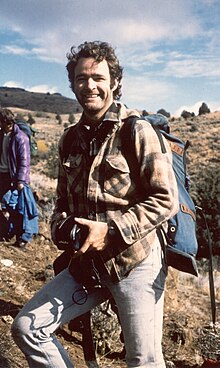Gregory Retallack
| Gregory Retallack | |
|---|---|

Greg Retallack, near Suplee, central Oregon, 1982
|
|
| Born |
8 November 1951 Hobart, Tasmania |
| Residence | United States |
| Nationality | Australian |
| Citizenship | American and Australian |
| Alma mater |
Macquarie University, University of New England (Australia) |
| Known for | Paleopedology |
| Spouse(s) | Diane Retallack, Director Eugene Concert Choir |
| Website | http://pages.uoregon.edu/dogsci/doku.php?id=directory/faculty/greg/about |
| Scientific career | |
| Thesis | A biostratigraphy for terrestrial Triassic rocks of Gondwanaland (1978) |
| Doctoral advisor | Rodney E. Gould |
| Influences | Bruce Runnegar, David Dilcher, James Lovelock |
Gregory John Retallack (born 8 November 1951) is an Australian paleontologist, geologist, and author who specializes in the study of fossil soils (paleopedology). His research has examined the fossil record of soils though major events in Earth history, extending back some 4.6 billion years. Among his publications he has written two standard paleopedology textbooks, said N. Jones in Nature Geoscience "Retallack has literally written the book on ancient soils."
Retallack moved with his family from Hobart, Tasmania at age 4. He grew up in Hurstville and then Epping, in the suburbs of Sydney, New South Wales. He attended The King's School, Parramatta, then studied biology and paleontology at Macquarie University. He received a BSc Hons with University Medal in 1974 from the University of New England (Australia) and a Ph.D. in 1978 in geology from the same university. After a postdoctoral fellowship at Indiana University he joined the faculty at the University of Oregon in 1981. He has been a professor in the Department of Geological Sciences since 1992, and Director of the Condon Collection of the University of Oregon Museum of Natural and Cultural History since 2009.
In 1973, Retallack discovered that paleosols were preserved among fossil roots below some kinds of fossil plant horizons and that paleosols could reveal aspects of plant communities difficult to infer from the fossil plants themselves. This novel approach to reconstructing life on land could be applied to understanding major events in evolution, sometimes supplementing and sometimes challenging prior understanding. Initial work was on Triassic vegetation and climate. Later construction of Cenozoic paleoclimate time series led to the idea that grassland-grazer coevolution was responsible for climatic cooling over the past 50 million years, which has implications for biosequestration of carbon. Fieldwork in Kenya on paleosols associated with apes (Proconsulidae) ancestral to humans revealed that the evolutionary transition to upright stance occurred in woodlands rather than savannas. Paleosols of the Cretaceous-Paleogene boundary in Montana implicated abrupt paleoclimatic change and acid rain from extraterrestrial impact in the extinction of dinosaurs Work on the Permian-Triassic boundary in Antarctica lead to formulation of an hypothesis of greenhouse crisis due to methane outburst associated with flood basalt in this greatest of all mass extinctionsDevonian fossil soils at sites for tetrapods suggest a woodland hypothesis for the evolutionary transition from fish to amphibian.
...
Wikipedia
